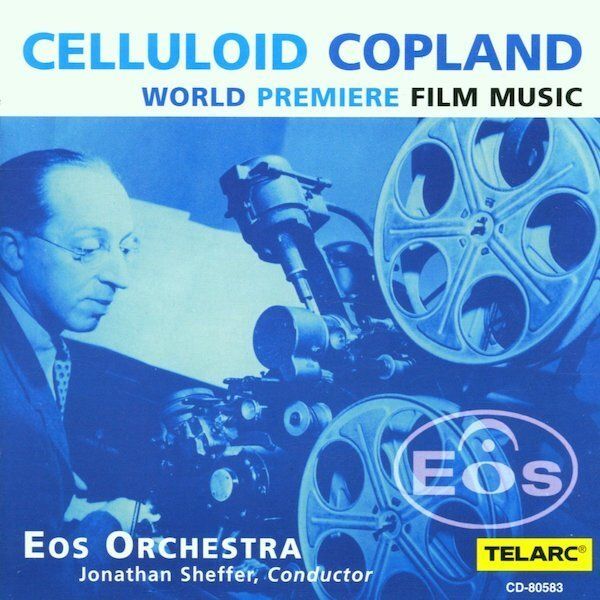Celluloid Copland

Label: Telarc CD-80583
Release Date: 23-Jan-2001
Total Duration: 56:33
UPN: 089408058325
Contains music from: From Sorcery To Science, Incidental Music For A Puppet Show, The City, The Cummington Story, The North Star
These four scores written for films had been inaccessible for many years and are now newly exhumed from the Library of Congress.
Two trace their origins to films for the modernistic New York World Fair. The Fair was held in a fateful year: 1939. The same event also drew two British concert commissions premiered by Boult in New York. These were Arnold Bax's Seventh and final symphony and Arthur Bliss's grandiloquent though flawed Piano Concerto played by Solomon though, to my knowledge, only John Ogdon, playing it as if it were the Mennin concerto, has made something remarkable out of it.
These Copland scores were written to keep the wolf from the door. The studios paid well and Copland was still struggling for security though the years 1939-45 saw many of his most enduringly popular scores produced. From Sorcery to Science is a sequence of miniatures ranging from airy chinoiserie (à la Li Tai Po as set by Mahler, Bliss and Lambert), to a jazzy coven, to the eerie nocturnal chimes of alchemy (like the witchery in de Falla's El Amor Brujo), Voodoo filtered through Chabrier's España to the prairie clink and swing of March of the Americas. This is frankly the most ingenious 'post-carderie'. The scale and treatment recalled for me the Arthur Bliss Conversations which predated the Copland pieces. Bliss, with strong US connections, spent the late 1930s and early 1940s in the USA until his return to wartime England a BBC post effectively as one of Boult's assistants.
After seven ultra-brevities the suite from the music for The City permitted Copland a more generous canvas on which to develop his ideas. Most of the movements last more than two minutes and two more than four minutes. This permits a Liadov-scaled vignette and avoids boredom. The music resonates with snatches of works to come and works just written. I must single out the smooth poetry of Lino Gomez's bass saxophone which weaves a way through the New England Countryside and The Steel Mill the latter of which I expected to be more like Mossolov's Iron Foundry. The music has something of Appalachian Spring (for years in the future) but there is also angst. I wonder if Copland, with his Socialist agenda, was also trying to portray the oppression of city life as well fighting as a subversive against the sub- and supra- text of the World Fair which was meant to be positive towards the industrial society. The boogie of Fire engines at lunch hour reminded me very strongly of Nyman's Where the Bee Sucks with its buzzing surging strings which reappear as a motif in Taxi Jam with its whistles and yet more boogie. The New City is a lovely pastoral movement - if this is a city it is a garden city.
The Cummington Story was also a documentary. This took as its theme the settlement of refugees in a rural Masachussets town. This is the cue for the most pastoral music which inhabits the same dells and pastures as The Tender Land and Appalachian Spring. The Eos violins seem a little hard-edged here though otherwise quite admirable.
Only one 'traditional' feature film is represented on this collection and Copland wrote music for only a couple. The North Star, an action story of Russian partisans and guerilla warfare with the Nazis, starred Walter Houston, Farley Grainger, Anne Baxter and, as the villainous Nazi, Erich von Stroheim, playing an accustomed role. The music is busy, clear, Russian-inflected and somewhat poster-ish. It was written at the brief peak of Soviet-American alliance when the Khachaturyan Violin Concerto did the rounds of the US orchestras, when celebrity conductors bid for the honour of the US premiere of Shostakovich's Leningrad Symphony (whose remorseless acidic march can be discerned in some of the music). After the moment had passed history was rewritten and crass exercises such as the re-editing of the film and re-release as Armored Attack with a less favourable take on the Russian role.
The movements are: From Sorcery to Science: Opening Fanfare, Chinese Medicine Man, The Witch's Cauldron, The Alchemist, African Voodoo, The Modern Pharmacy, March of the Americas. The City: Main title, The Steel Mill, The Sorrow of the City, Fire Engines at Lunch Hour, Taxi Jam, Sunday Traffic, The New City, End Title. The North Star: Main title, Death of the Little Boy, Going to School, Damian is Blind, Song of the Guerillas (to words by Ira Gershwin sung here with feeling by the Collegiate Chorale/Roger Bass), North Star Battle, The Children's Return, Guerillas Return, Leaving the Village.
This is a rather special project carried off with stylish engagement by Sheffer (who contributes the notes) and his collaborators in the Eos and at Telarc. A worthwhile addition to the Copland discography. The undiluted dedication to filling gaps in the Copland discography has to be admired.
Originally published @ MusicWeb International © 2000 / Text reproduced by kind permission



